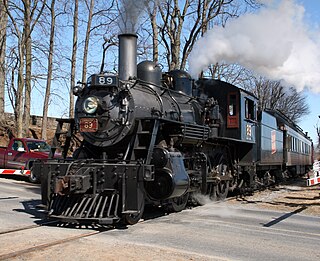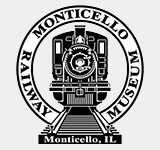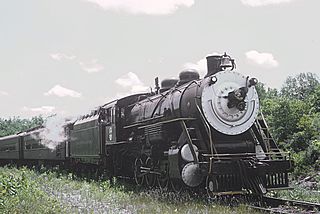
Under the Whyte notation for the classification of steam locomotives, 4-8-4 represents the wheel arrangement of four leading wheels on two axles, eight powered and coupled driving wheels on four axles and four trailing wheels on two axles. The type was first used by the Northern Pacific Railway, and initially named the Northern Pacific, but railfans and railroad employees have shortened the name since its introduction. It is most-commonly known as a Northern.

The Chicago, Burlington and Quincy Railroad was a railroad that operated in the Midwestern United States. Commonly referred to as the Burlington Route, the Burlington, or as the Q, it operated extensive trackage in the states of Colorado, Illinois, Iowa, Missouri, Nebraska, Wisconsin, Wyoming, and also in Texas through subsidiaries Colorado and Southern Railway, Fort Worth and Denver Railway, and Burlington-Rock Island Railroad. Its primary connections included Chicago, Minneapolis–Saint Paul, St. Louis, Kansas City, and Denver. Because of this extensive trackage in the midwest and mountain states, the railroad used the advertising slogans "Everywhere West", "Way of the Zephyrs", and "The Way West".

Under the Whyte notation for the classification of steam locomotives, 2-6-0 represents the wheel arrangement of two leading wheels on one axle, usually in a leading truck, six powered and coupled driving wheels on three axles and no trailing wheels. This arrangement is commonly called a Mogul.
A 2-8-8-2, in the Whyte notation for describing steam locomotive wheel arrangements, is an articulated locomotive with a two-wheel leading truck, two sets of eight driving wheels, and a two-wheel trailing truck. The equivalent UIC classification is, refined to Mallet locomotives, (1'D)D1'. These locomotives usually employ the Mallet principles of articulation—with the rear engine rigidly attached to the boiler and the front engine free to rotate—and compounding. The 2-8-8-2 was a design largely limited to American locomotive builders. The last 2-8-8-2 was retired in 1962 from the N&W's roster, two years past the ending of steam though steam was still used on steel mill lines and other railroads until 1983.

The St. Louis–San Francisco Railway, commonly known as the "Frisco", was a railroad that operated in the Midwest and South Central United States from 1876 to April 17, 1980. At the end of 1970, it operated 4,547 miles (7,318 km) of road on 6,574 miles (10,580 km) of track, not including subsidiaries Quanah, Acme and Pacific Railway and the Alabama, Tennessee and Northern Railroad; that year, it reported 12,795 million ton-miles of revenue freight and no passengers. It was purchased and absorbed into the Burlington Northern Railroad in 1980. Despite its name, it never came close to San Francisco.

The St. Louis Southwestern Railway Company, known by its nickname of "The Cotton Belt Route" or simply "Cotton Belt", is a former Class I railroad that operated between St. Louis, Missouri, and various points in the U.S. states of Arkansas, Tennessee, Louisiana, and Texas from 1891 to 1980, when the system added the Rock Island's Golden State Route and operations in Kansas, Oklahoma, and New Mexico. The Cotton Belt operated as a Southern Pacific subsidiary from 1932 until 1992, when its operation was assumed by Southern Pacific Transportation Company.

The Boone and Scenic Valley Railroad is a heritage railroad that operates freight and passenger excursions in Boone County, Iowa.

The Illinois Terminal Railroad Company, known as the Illinois Traction System until 1937, was a heavy duty interurban electric railroad with extensive passenger and freight business in central and southern Illinois from 1896 to 1956. When Depression era Illinois Traction was in financial distress and had to reorganize, the Illinois Terminal name was adopted to reflect the line's primary money making role as a freight interchange link to major steam railroads at its terminal ends, Peoria, Danville, and St. Louis. Interurban passenger service slowly was reduced, ending in 1956. Freight operation continued but was hobbled by tight street running in some towns requiring very sharp radius turns. In 1956, ITC was absorbed by a consortium of connecting railroads.
The 5-mile (8.0 km) Reader Railroad was a tourist-only railroad operating in Reader, Arkansas from 1973 to 1991. As a 23-mile (37 km) common carrier prior to May 1973, it was the last all steam locomotive-powered, mixed train railroad operating in North America. It operated trackage in Ouachita County and Nevada County, Arkansas. The five mile tourist railroad operated until 1991, when it could not meet the new federal safety regulations.

The Monticello Railway Museum is a non-profit railroad museum located in Monticello, Illinois, about 18 miles west of Champaign, IL. It is home to over 100 pieces of railroad equipment, including several restored diesel locomotives and cars.

St. Louis–San Francisco 4018 is a class USRA Light 2-8-2 "Mikado" steam locomotive which operated for three decades hauling freight between Bessemer and Birmingham, Alabama, on the St. Louis–San Francisco Railway. It went on display at the Alabama State Fairgrounds in 1952 and is one of only a few locomotives of its type that survive.

The Crab Orchard and Egyptian Railway is a Class III common carrier shortline railroad that operates in the cities of Marion and Herrin in the Southern Illinois region. It is most historically recognized by the FRA for being the last U.S. railroad of any kind to use steam locomotives exclusively in regular revenue freight service up until March 1986.

The Stone Mountain Scenic Railroad (SMRR) is a standard gauge railroad that circles the perimeter of Stone Mountain Park in a loop, and provides views of the mountain en route.

Western Maryland Scenic Railroad No. 734, also known as Mountain Thunder, is an SC-1 class 2-8-0 “Consolidation” type steam locomotive originally built by the Baldwin Locomotive Works in 1916 for the Lake Superior and Ishpeming Railroad (LS&I) as No. 18. It was renumbered to 34 in 1925. No. 34 was used to pull heavy iron ore trains for the LS&I, until it was retired in 1961. The locomotive was subsequently sold to the Marquette and Huron Mountain Railroad, where it was stored in a sideline alongside other LS&I steam locomotives. In 1971, No. 34 was sold to the Illinois Railway Museum for static display.
Lake Superior and Ishpeming Railroad No. 33 is a preserved SC-1 class 2-8-0 "consolidation" type steam locomotive originally built by the Baldwin Locomotive Works in April 1916 for the Munising, Marquette and Southeastern Railway as No. 44. In 1924, the MM&SE was purchased by the Lake Superior and Ishpeming Railroad and the locomotive was renumbered to 33. It served the LS&I by pulling heavy iron ore trains until it was retired from revenue service in 1962. The following year, it was sold to the Marquette and Huron Mountain tourist railroad to operate in excursion service, but instead sat idle in Marquette. In 1965, No. 33 was purchased by the founders of the Hocking Valley Scenic Railway in Ohio. Rebuilt to operating condition, No. 33 ran on the HVSR for many years before being sidelined in 1996 for an FRA-required overhaul that couldn't be accomplished. In 2003, No. 33 was traded to the Ohio Central Railroad and was overhauled for some occasional excursion runs between 2005 and 2008. The locomotive briefly operated again around the Age of Steam Roundhouse between 2018 and 2020. As of 2024, No. 33 is sidelined, awaiting to go through a 1,472-day inspection.

Grand Trunk Western No. 6323 is a preserved class "U-3-b" 4-8-4 "Northern" type steam locomotive built by Alco in 1942. It served the Grand Trunk Western Railroad by pulling various heavy freight and passenger trains across the Lower Peninsula of Michigan and Northern Indiana. It became famous in later years for being the very last active steam locomotive to run on the GTW's trackage while still on the railroad's active list in 1961. After sitting in storage for several years in Detroit, No. 6323 was sold in 1981 to the Illinois Railway Museum, and since then, it has remained on static display in Union, Illinois.

Buffalo Creek and Gauley Railroad No. 4 is a preserved 2-8-0 "Consolidation" type steam locomotive. It was constructed by Baldwin in 1926 as the only locomotive to be bought-new by the Buffalo Creek and Gauley Railroad. It served the railroad by pulling coal and lumber trains throughout Clay County, West Virginia until it was retired in 1965. No. 4 was restored to operating condition by the Quakertown and Eastern Railroad for excursion service in Pennsylvania, and it made its way to the North Carolina Transportation Museum in 1978. No. 4 was subsequently used to pull tourist trains across the museum's property in Spencer, North Carolina from when its multi-year overhaul was completed in 1986 to when its flue time expired in 2001. The locomotive spent fourteen years in storage, waiting for a rebuild that never came to fruition. In 2015, No. 4 was purchased by the Durbin and Greenbrier Valley Railroad, who moved it to their shops with the hopes of restoring it to run it on their trackage between Durbin and Cass, West Virginia.

Valley Railroad No. 40 is a preserved 2-8-2 "Mikado" type steam locomotive that was built by Alco in 1920. It was initially built as No. 101 for the Portland, Astoria and Pacific Railroad as part of their small order of locomotives. However, the order was cancelled, and the locomotive was subsequently sold to the Minarets and Western Railway to pull logging trains. No. 101 subsequently went through several ownerships during revenue service, until it was retired in 1950, and by that time, it was renumbered to 40. After spending several years in storage, No. 40 made its way to the Connecticut Valley Railroad in Essex in 1977. As of 2022, No. 40 is being used to pull tourist trains between Essex and Hartford, Connecticut alongside 2-8-0 No. 97 and 2-8-2 No. 3025.

Polson Logging Company 2 is a 2-8-2 “Mikado” steam locomotive built by Baldwin in 1912. It was originally built for the Saginaw Timber Company to pull logging trains. After that, it went through several ownership changes throughout both the steam era and the preservation era, before it was purchased by caretaker Skip Lichter in 1982. Lichter restored Polson Lumber 2 to operational condition and loaned it to the Mid-Continent Railway Museum in North Freedom, Wisconsin. The engine was later removed from service in 2000 to undergo a federally-mandated rebuild. Disagreement over who should cover the restoration costs ultimately led to an arbiter finding in Lichter's favor. After a 16-year restoration process, Polson Logging 2 returned to full steam in 2016. It was moved to the Oregon Coast Scenic Railroad the next year to operate on the railroad in Garibaldi, Oregon. As of 2023, it is owned by Rick Franklin, and it is stored at the Oregon Rail Heritage Center for use in pulling their Christmas trains in Oaks Park. It was set be moved to the Albany and Eastern Railroad some time in 2023, until a boiler tube leak prompted Oregon Rail Heritage Center to commence the 15-year overhaul of the locomotive's boiler.
Huntingdon and Broad Top Mountain Railroad and Coal Co. 38 is a preserved 2-8-0 "Consolidation" type steam locomotive. It was built by Baldwin in April 1927 for use on the Huntingdon and Broad Top Mountain Railroad and Coal Company in south central Pennsylvania in the United States, which commonly used the locomotive to pull short-distance freight trains, as well as occasional passenger trains, until the railroad shut down operations in 1954. The locomotive was subsequently acquired by the Rail City Historical Museum in Sandy Creek, New York for static display. In the late 1960s, No. 38 was sold to the Livonia, Avon and Lakeville Railroad in Lakeville, New York, who restored the locomotive to operating condition to pull their excursion trains. In 1977, the locomotive was sold again to the Gettysburg Railroad, which used the locomotive to pull their own tourist trains until 1986, when No. 38 was transferred to the Knox and Kane Railroad to be used there. The locomotive had been removed from service in 1989 for a long-term overhaul that was eventually completed, but it never returned to service for the Knox and Kane. After No. 38 fell victum to an arson-related roundhouse fire in 2008, it was sold at an auction to Alan Maples for the Everett Railroad. As of 2023, the Everett Railroad is restoring No. 38 to operating condition for use in excursion service alongside 2-6-0 No. 11.



















